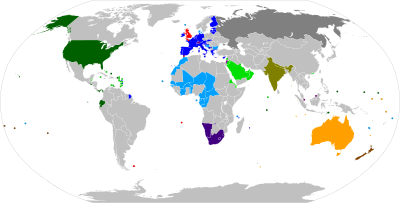Our website is made possible by displaying online advertisements to our visitors.
Please consider supporting us by disabling your ad blocker.
Currency substitution
This article needs additional citations for verification. (January 2014) |

Currency substitution is the use of a foreign currency in parallel to or instead of a domestic currency.[1]
Currency substitution can be full or partial. Full currency substitution can occur after a major economic crisis, such as in Ecuador, El Salvador, and Zimbabwe. Some small economies, for whom it is impractical to maintain an independent currency, use the currencies of their larger neighbours; for example, Liechtenstein uses the Swiss franc.
Partial currency substitution occurs when residents of a country choose to hold a significant share of their financial assets denominated in a foreign currency. It can also occur as a gradual conversion to full currency substitution; for example, Argentina and Peru were both in the process of converting to the U.S. dollar during the 1990s.
- ^ New estimates of U.S. currency abroad, the domestic money supply and the unreported Economy Edgar L. Feige September 2011.
Previous Page Next Page


